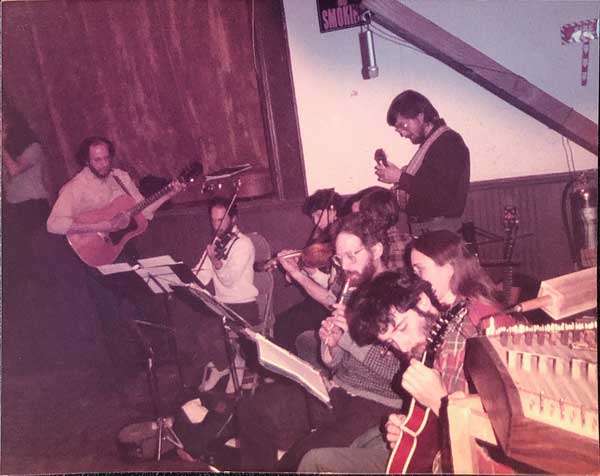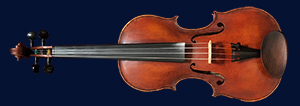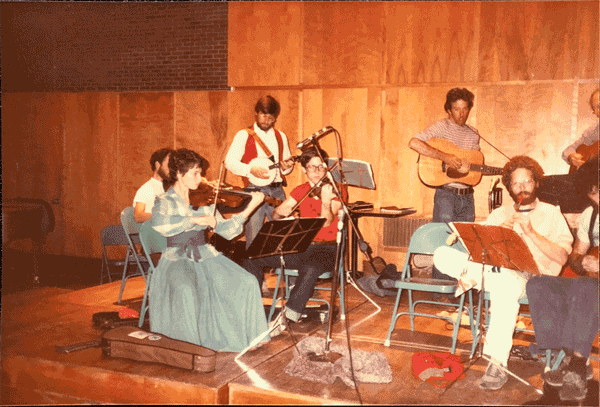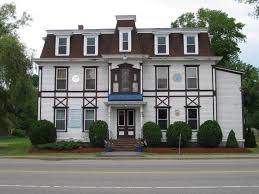Introduction
Recently [as written in 2007] I read an article in the CDSS News by New Mexico caller Merri Rudd on how and why she started to call. Her circumstances were in most ways so different from mine that it made me think about how and why I started to call. Briefly, she started to call because as a dancer of many years who wasn’t a musician, she wanted in some way to become more involved with and to make a greater contribution to her dance community. The process of preparing for her first dance was a rather drawn out affair, and her first dances were rather difficult for her, in part because she still had to learn how to hear the music as well as learn to call the dances. Furthermore, it sounds like she was calling for fairly large urban dances.
I started calling with the Lamprey River Band, together with Sarah Mason. Fortunately we kept rather complete records of band history in those days, so I don’t have to rely only on my incomplete memory. Our early stories can’t really be separated as we started together. In the Spring of 1983 we’d been having a weekly jam session for some time at which we played mainly New England contradance music.
At that time there were dances on second and fourth Fridays in Newmarket in the Town Hall on Main Street. They were enjoyable dances, but not all that large, and the series was struggling financially. It occurred to me to get the jam session to practice to play for a dance as a benefit for the dance series. We practiced for at least a few months, during which time a number of people found out about our idea and asked to join us; some of them were much better than any of us who had been meeting previously and that made for a stronger group. By the time of the first dance on July 29 (a special fifth Friday dance), we had roughly a dozen musicians, including four fiddlers.
LRB First Dance
At our first dance we had to hire people: we needed a strong backup player, a caller and a sound system. We counted on our numbers in the fine country dance orchestra tradition to make ourselves heard, but we didn’t want the caller (Rick Barkhuff) to have to call the entire dance unassisted. Fortunately we were able to get Allan Brock to play for us; he was an excellent guitar player and he had a sound system.
The dance went well; we played a bit stiffly but it still sounded good and the dancers had fun. We had such a good time that we decided to reconstitute ourselves as a long-term band. By the fall both Rick MacAulay and Dave Stone joined the band so that solved our backup problem; although as I remember we continued to get Allan to play for us for a while because we liked him and we still needed a sound system. We put away money after each dance and after a while we bought a sound system. At that point our main dependency was on outside callers.
Historical note 1: Four of the original members are still in the band (Sarah H, Sarah M, Steve and me); Burt joined about 5-6 years later to complete the current list of official members; and Marianne has been playing piano unofficially but greatly appreciated for probably close to ten years now. [Currently, in 2020, Steve, Sarah, Sarah and I are still members. Burt and Marianne, sadly, are no longer around.]
Historical note 2: We danced in the Town Hall for about six years, but circumstances forced us to move. For more about the Newmarket Town Hall and the dances, click on this link.


Learning to Call
So about a year after the band formed, Sarah Mason and I started talking about the idea of learning to call dances; that would allow us to do a dance completely on our own. As I remember we learned in a variety of ways. Of course we looked in books for dances. But more than that, we went to dances and paid attention. I remember, both before and after the first dance we called, going to other callers' dances and paying attention to each dance that was called. If I enjoyed it, while waiting out at the bottom of the set I'd quickly write down the dance. I remember asking many callers for the name of a dance so I could look it up afterwards, or asking for the figure I hadn’t been able to remember as I was trying to write it down. Of course, living in the Seacoast area, we were ideally located for learning dances. I could go to a local or Monadnock dance and learn from Tod Whittemore, Steve Zakon, Mary DesRosiers, and Ken Wilson. I could go to a local or central New Hampshire dance and learn from Dudley Laufman. I could go to Maine and learn from all the Maine Country Dance Orchestra callers and others.

Photo of my fiddle, made by Don Roy.
Beyond just learning the dances, as a psychologist it didn’t take me very long to figure out that one of the most important parts of calling is teaching. (That was brought home to me very dramatically a few years after I started calling when I watched a respected caller who shall go unnamed take about five minutes to teach an easy figure at the Ralph Page Weekend to a crowd of experienced dancers, and a couple weeks later watched George Marshall teach the same figure at a Swallowtail dance in Durham in about thirty seconds.) So I observed how different people taught different figures and learned which ways worked and which ways didn’t work as well.
Finally, after a few months of paying attention and taking notes, we were reasonably prepared, and on August 18, 1984 - just over a year after the band started playing, and on our twentieth dance (we were younger back then; we kept up a busy schedule!), Sarah and I called the dance at the Northwood Masonic Hall after the Northwood Fair. As I remember, we wrote out the program in advance, with contingency plans for if the group was more or less advanced, and I’m sure with at least tentative tune choices for most dances.
Calling the Dance
|I don’t remember being all that nervous but I’m sure I was. I know we enjoyed it, and the dancers did—enough that we kept on calling. I’m pretty sure we came up with the pattern right from the beginning of alternation: each of us would call two dances followed by the other calling two dances. I still prefer to call a dance with someone else; it’s fun that way whereas it’s work to do an entire evening by myself. I may not have as complete control over the program, but I get to play more and it’s much more relaxed.
Note from 1/2020: We've been doing the Durham dance for several months now. It's a small, relaxed dance. Sarah Mason has, at least temporarily, stopped calling. In that context I'm enjoying very much calling most of the dance.
I believe we had some new people and some of the regular dancers. But unlike many callers, both of us learned from Dudley, and we knew right from the beginning that it’s important to have a collection of dances that includes easy dances as well as more complicated dances. My other rule in choosing dances, right from the beginning, has been that for a dance to get into my collection it has to be something I enjoy dancing! That doesn’t guarantee that others will enjoy it, but I certainly can’t expect others to enjoy it if I don’t. That applies to the easy dances as well as the more complex ones.
So that’s the story of how and why I learned to call dances. I don’t call as much as I used to, but I still enjoy calling dances; I especially enjoy calling at the local dances where many of the dancers are my friends, and for groups of beginners who are just discovering this kind of music and dance and who have the fresh excitement and enthusiasm that people have when they first discover such a wonderful thing as contradancing.
It would be interesting to hear about how other callers started calling. I could put such stories on the web site. Feel free to send me your stories.*
*My e-mail address is available in various places on this web site (my name with a dot in the middle at unh dot edu - isn’t it too bad we have to disguise everything these days!)
Update, Oct. 2019. Sadly, on Saturday Sept. 28, 2019, a major fire broke out in the Masonic Hall, and it burned to the ground. Although we didn't have dances there frequently, I have a number of fond memories of dancing in the hall. I remember that when dancing squares, we didn't want to be the number one couple in the set at the top of the hall. There was a hump in the floor that was substantial enough to make it a bit difficult to dance there if the first set was too close to the stage! But otherwise it was a very nice hall, and I remember the floor as being very good to dance on.



